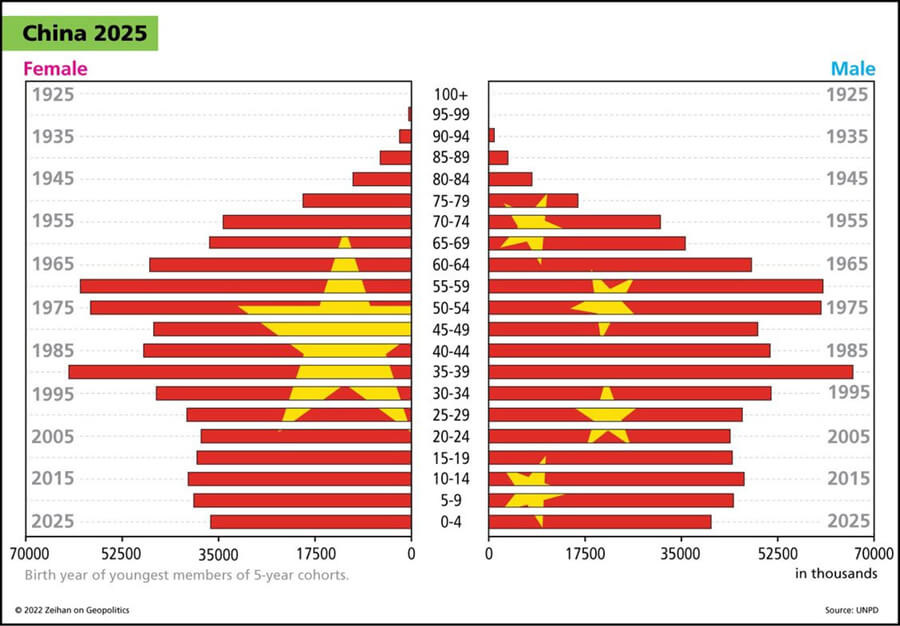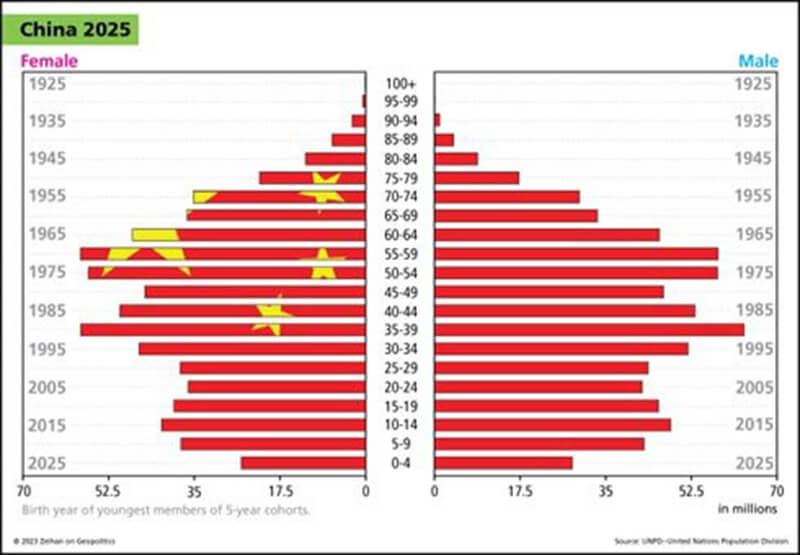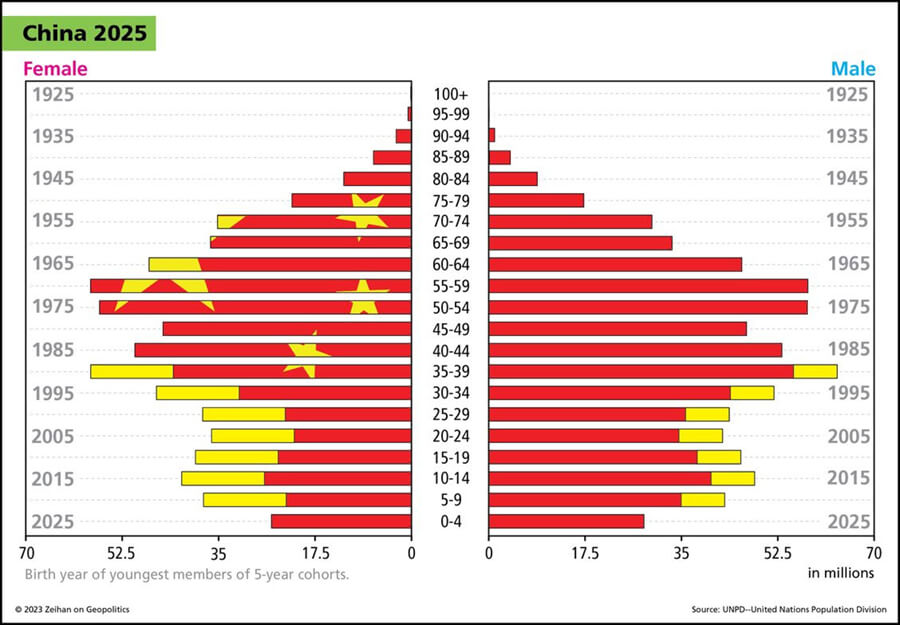Today we’re breaking down the new demographic data from the Chinese space. This will allow us to make some much-needed updates to an already bleak assessment…and spoiler alert, it’s going to get a lot worse.
The first graph shows us the demographic picture before any of this new data were released. You’ll notice China already has an incredibly fast-aging population. The number of people entering the workforce can’t keep up with retirees, so even when using the old data, labor costs were increasing faster than any country in history.

The second graph shows us what the new data are saying. The number of children under age five has collapsed, leaving China with nearly half the amount of five-year-olds as fifteen-year-olds. This happened well before COVID drove down birth rates and increased death rates. Even though this is the “official” Chinese data, it’s likely overly optimistic.

So that brings us to our internal extrapolation of the data as seen in graph three. Again this is our interpretation, but it gives you a better look at the Chinese predicament. Leaks out of China suggest the yellow bars don’t even exist; this means China isn’t a country in demographic decay…its a country in the advanced stages of demographic collapse.

China is entering its final decade of operating as a modern industrialized nation. For any foreign business still in China, those sunk costs on factories can only keep you there for so long…and it will only get worse from here on out.
Prefer to read the transcript of the video? Click here
Here at Zeihan On Geopolitics we select a single charity to sponsor. We have two criteria:
First, we look across the world and use our skill sets to identify where the needs are most acute. Second, we look for an institution with preexisting networks for both materials gathering and aid distribution. That way we know every cent of our donation is not simply going directly to where help is needed most, but our donations serve as a force multiplier for a system already in existence. Then we give what we can.
Today, our chosen charity is a group called Medshare, which provides emergency medical services to communities in need, with a very heavy emphasis on locations facing acute crises. Medshare operates right in the thick of it. Until future notice, every cent we earn from every book we sell in every format through every retailer is going to Medshare’s Ukraine fund.
And then there’s you.
Our newsletters and videologues are not only free, they will always be free. We also will never share your contact information with anyone. All we ask is that if you find one of our releases in any way useful, that you make a donation to Medshare. Over one third of Ukraine’s pre-war population has either been forced from their homes, kidnapped and shipped to Russia, or is trying to survive in occupied lands. This is our way to help who we can. Please, join us.
CLICK HERE TO SUPPORT MEDSHARE’S UKRAINE FUND
CLICK HERE TO SUPPORT MEDSHARE’S EFFORTS GLOBALLY
TRANSCIPT
Hey everybody. Peter Zeihan here coming to you from Marshalltown, Iowa. My mom was a little upset that the videos I did earlier did not have a flower garden in the background. So we. Topic today is Chinese demographics. We’ve gotten some new data out of the Chinese that has made it way to the U.N. and so the updates have allowed us to update our assessment and oh, my God, it’s bad.
Okay. So let’s start with this first graphic to show you where the official data have us. As of a year and two years ago, this narrowing for the bottom seven blocks is the fastest aging workforce in the world and arguably the fastest one in human history. This indicates that the number of new workers coming in is so small compared to the number that are retiring, that you’re having massive increase in labor costs and from adjacent numbers that we do trust.
I mean, Chinese data is always a little touch and go, but from the numbers that we do have that we do trust, which is labor costs, Chinese labor is increasing at the fastest pace of any country in any era at any time in history, including during the Black Death itself. Since 2000, the cost of Chinese labor has gone up by about a factor of 15, while the size of the Chinese economy has only expanded by a factor of but roughly 3.5 to 4.
So really, really bad. The Chinese are only in industrial power today under this data because of the sunk cost of the industrial plant that it took to build everything that’s there in the first place. Now, that’s not nothing that is huge. That’s, you know, trillions of dollars, tens of trillions of dollars. And it’s highly relevant. But most industries and most subsectors that have decided to relocate to other countries have discovered that they’ve got shorter, simpler supply chains where there are a lot less of a political headache.
Okay. Here is the new data. And as you can see, that the number of children who are under age five has just collapsed. And there are now roughly twice as many that are age 15 as there are age five. What happened back in 2017, well before COVID, is that we had a sudden collapse in the birth rate roughly 40% over the next five years.
Among the Chinese, the ethnic Han population and more than 50% among a lot of the minorities, and that is before COVID, which saw anecdotally the birth rate dropped considerably more and before COVID, which probably raised the death rate considerably. What we’re never going to get good data on death rate, or at least not anytime soon, because the Chinese, when they did the reopening, they just stopped collecting the data on deaths and COVID and everything because they didn’t want the world to know how many Chinese died.
So they don’t know. With this data, this snapshot in time, this is official state data. It’s still probably not wildly accurate. We still have the Shanghai Academy of Sciences, which is like the kind of the biggest nerd group you’ve got in the in the country, saying that the country has over counted their population under age 45 by over 100 million people in the aftermath of the one child policy.
And so really, what we need to consider is that that official data and at the very bottom, you need to play that up. And this last graphic kind of shows you our internal estimate of where that is. Now, this is not official, but those yellow bars probably don’t exist. But that is not what the official data is saying.
This is an extrapolation from the from what? The Shanghai Academy of Sciences is saying. Anyway, some version of this is probably the truth, which means that China aged past the point of demographic, no return over 20 years ago. And it wasn’t just this year that India became the world’s most populous country. That probably happened roughly a decade ago.
And it was it in 2018 that the average Chinese aged passed the average American. That was probably roughly in 2007 or 2008. So this is not a country that is in demographic decay. This is a country that is in the advanced stages of demographic collapse. And this is going to be the final decade that China can exist as a modern, industrialized nation state because it simply isn’t going to have the people to even try.
So for those of you who have business in China, you’re becoming more and more aware of the political system. You’re becoming aware that it’s becoming illegal for foreigners to even access data, data that in most countries is publicly available. You now have on top of that to figure out that not only is the labor force never recovered and the labor costs you’re having now are as low as they’re ever going to be, consumption is as high as it’s ever going to be.
So even before you consider the political complications or issues with operating environment or energy access or geopolitical risk or reputational risk, the numbers just aren’t there anymore. So you have to ask yourself why you’re still there. Sunk costs of industrial warfare. That’s a reasonable answer, but it becomes less relevant with every passing year as everything else catches up.
All right, you guys take care.








